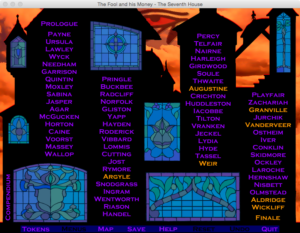The Fool and his Money: Mystery
If I had to describe the feel of The Fool and His Money in one word, I’d choose “enigmatic”. You might think that’s a given for a puzzle game, but I’m not even talking about the content of the puzzles so much as everything else about and around them.
The basic format of the game is this: From a menu, you can access a series of pages. Each page contains a fragment of story, just a few sentences long, accompanied by an illustration, with all characters shown in silhouette, like shadow puppets — something inherited from The Fool’s Errand, where it was to some extent a reaction to the graphical limitations of the original Macintosh, but the effect is attractive and creates a sense of mystery from the get-go. Each illustration contains a puzzle, usually a word puzzle of some sort, but there are exceptions. Seventeen pages are available to start with; the rest are locked, and unlock in fixed sequence as you solve puzzles. In addition, solving a puzzle extends the story fragment on that page to fill in more of the story, and in many cases alters the illustration, adding words or jumbled letters of unclear significance. Presumably these are part of a metapuzzle to be solved after you complete all the pages, which means that at the moment they’re revealed, they’re a puzzle that’s out of your reach, a message that you can’t even begin to decipher yet. Enigmatic.
Even ignoring the puzzles, the story itself is something of a mystery. The original Fool’s Errand had a fairly simple good-vs-evil plot, with the High Priestess from the Tarot as the bad guy, seizing the power of the Book of Thoth to place curses on the land, and with various other Tarot cards, notably including the Sun, helping the Fool against her. TFaHM starts out with the Sun apparently betraying the Fool while the High Priestess suddenly turns helpful, and it proceeds by generally casting doubt on everyone’s motives and revealing things that were said in the first game to be lies. You soon wind up with no idea what’s really going on. And this effect is enhanced by the fact that you’re missing important chunks of the story.
See, the puzzles vary a lot in difficulty. So I’m not solving them in linear sequence. I’ll hit a difficult puzzle, maybe solve it partway, and then break off to solve other, easier puzzles. And since the story is revealed by solving puzzles, this means there are gaps in the story I’ve seen, some of them quite significant for understanding the plot.
And that’s before we even get into the secret pages.
 They’re not really all that secret. Just… non-obvious. The puzzle menu is in the form of a large building with the names of the pages on its walls, between and around a set of stained glass windows. In my initial pass at the game, I didn’t go back to this menu much: until I had sampled all the unlocked pages and had to start backtracking, it was simpler to just keep using the “next page” button. So it took me a while to notice that the windows were changing color, indicating that they were unlocking too. They link to a sequence of pages whose relationship to the rest of the story is still unclear to me: in them, the Fool repeatedly sneaks into “the Seventh House”, whatever that is, and eavesdrops on a machiavellian Prince plotting all the calamities you observe elsewhere. And that’s just the start of a fairly large set of puzzles that aren’t in the main list, but do seem to be an essential part of understanding the later parts of the story.
They’re not really all that secret. Just… non-obvious. The puzzle menu is in the form of a large building with the names of the pages on its walls, between and around a set of stained glass windows. In my initial pass at the game, I didn’t go back to this menu much: until I had sampled all the unlocked pages and had to start backtracking, it was simpler to just keep using the “next page” button. So it took me a while to notice that the windows were changing color, indicating that they were unlocking too. They link to a sequence of pages whose relationship to the rest of the story is still unclear to me: in them, the Fool repeatedly sneaks into “the Seventh House”, whatever that is, and eavesdrops on a machiavellian Prince plotting all the calamities you observe elsewhere. And that’s just the start of a fairly large set of puzzles that aren’t in the main list, but do seem to be an essential part of understanding the later parts of the story.
 Comments(0)
Comments(0)